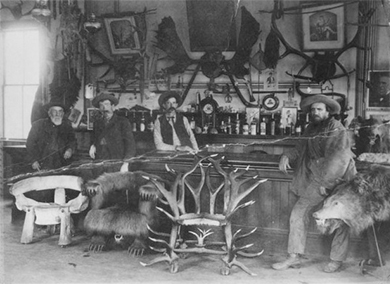| << Chapter < Page | Chapter >> Page > |
The popular image of the Wild West portrayed in books, television, and film has been one of violence and mayhem. The lure of quick riches through mining or driving cattle meant that much of the West did indeed consist of rough men living a rough life, although the violence was exaggerated and even glorified in the dime store novels of the day. The exploits of Wyatt Earp, Doc Holiday, and others made for good stories, but the reality was that western violence was more isolated than the stories might suggest. These clashes often occurred as people struggled for the scarce resources that could make or break their chance at riches, or as they dealt with the sudden wealth or poverty that prospecting provided.
Where sporadic violence did erupt, it was concentrated largely in mining towns or during range wars among large and small cattle ranchers. Some mining towns were indeed as rough as the popular stereotype. Men, money, liquor, and disappointment were a recipe for violence. Fights were frequent, deaths were commonplace, and frontier justice reigned. The notorious mining town of Bodie, California, had twenty-nine murders between 1877 and 1883, which translated to a murder rate higher than any other city at that time, and only one person was ever convicted of a crime. The most prolific gunman of the day was John Wesley Hardin, who allegedly killed over twenty men in Texas in various gunfights, including one victim he killed in a hotel for snoring too loudly ( [link] ).

Ranching brought with it its own dangers and violence. In the Texas cattle lands, owners of large ranches took advantage of their wealth and the new invention of barbed wire to claim the prime grazing lands and few significant watering holes for their herds. Those seeking only to move their few head of cattle to market grew increasingly frustrated at their inability to find even a blade of grass for their meager herds. Eventually, frustration turned to violence, as several ranchers resorted to vandalizing the barbed wire fences to gain access to grass and water for their steers. Such vandalism quickly led to cattle rustling, as these cowboys were not averse to leading a few of the rancher’s steers into their own herds as they left.
One example of the violence that bubbled up was the infamous Fence Cutting War in Clay County, Texas (1883–1884). There, cowboys began destroying fences that several ranchers erected along public lands: land they had no right to enclose. Confrontations between the cowboys and armed guards hired by the ranchers resulted in three deaths—hardly a “war,” but enough of a problem to get the governor’s attention. Eventually, a special session of the Texas legislature addressed the problem by passing laws to outlaw fence cutting, but also forced ranchers to remove fences illegally erected along public lands, as well as to place gates for passage where public areas adjoined private lands.

Notification Switch
Would you like to follow the 'U.s. history' conversation and receive update notifications?